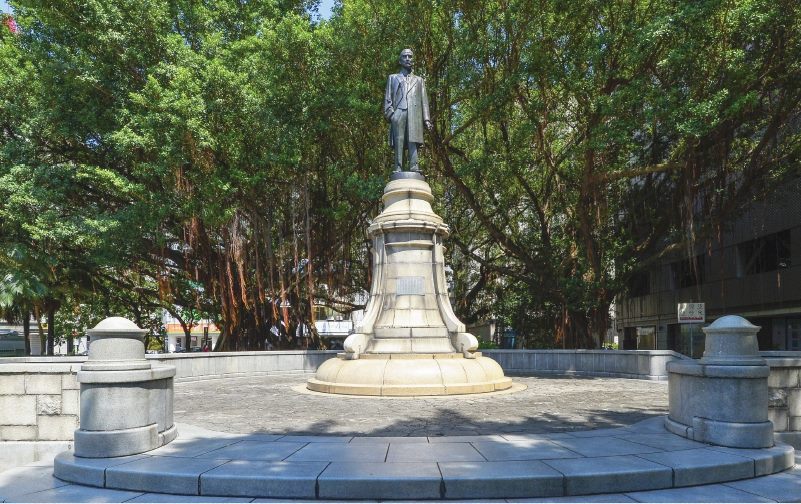
The Untold Stories of Dr. Sun Yat-sen Statue
Compiled and Written by the P.T.S. Sculpture Arts Foundation, 2025
Dr. Sun Yat-sen Statue (Registered as a General Antiquity by Taipei City Government in 2008)
The Statue of Dr. Sun Yat-sen stands approximately 300 cm tall and is dressed in Western formal attire with an overcoat. In his left hand, he holds a scroll of speech manuscripts at his side. His gaze is steady, bright, and piercing, yet it also conveys warmth and care, reflecting his relentless pursuit of his ideals. Although the figure portrays a Western intellectual appearance, its essence embodies Eastern virtues. The statue’s design, attire, gestures, and posture all showcase Dr. Sun Yat-sen’s deep compassion as a learned man.
The Sculptor: Pu Tian-sheng
Located in the northeast corner of the Taipei Zhongshan Hall Plaza, the Statue of Dr. Sun Yat-sen was created by sculptor Pu Tian-sheng. Born in 1912 in Chiayi, Taiwan, Pu began studying painting at the Tokyo Art School (now known as Tokyo University of the Arts) in 1932. Later, in 1934, he was taken under the wing of renowned Japanese sculptor Fumio Asakura, which set him on the path to becoming a sculptor. Pu returned to Taiwan in 1941 and devoted himself to figure sculpture. His works faithfully captured the essence of the human figure and helped establish the foundations of Western classical sculpture in Taiwan. This statue, completed in 1949, is the first large-scale outdoor bronze statue in Taiwan created by a local artist.
The Creation of the Statue
When the government inquired about candidates for the statue project, Chen Chengbo, the father-in-law of sculptor Pu Tiansheng, recommended that his son-in-law take on the commission. In 1945, Pu and his family moved from Chiayi to Taipei, where they established a studio and set up Taiwan's first bronze casting factory after the war.
At the end of World War II in 1941, Pu insisted on returning to Taiwan from Japan. His Japanese mentor, Fumio Asakura, gifted him over ten rare photographs of Dr. Sun Yat-sen. Pu used these photographs as reference material for the statue he was creating. He posted the photos on the wall and studied them for over two months. Additionally, he asked the then-Mayor of Taipei City, You Mijian, to arrange for him to sit in the front row when Sun Ke, the son of the founding father, delivered a speech at the Taipei Zhongshan Hall. During the speech, Pu closely observed Sun Ke's features, looking for similarities between him and Dr. Sun Yat-sen.
Pu continued working on the statue despite the turmoil of the February 28 Incident in 1947. By 1949, as the government reformed its currency system for price stabilization—where 40,000 old Taiwan dollars were exchanged for one New Taiwan dollar—the originally commissioned amount of 200,000 old Taiwan dollars was suddenly devalued to just 5 New Taiwan dollars. After the completion of the statue, there was no budget left for its installation. Fortunately, Mayor You promised that the city government would handle it. Pu eventually received NT$2,600 through additional fundraising efforts, which helped him avoid financial ruin and navigate this challenging period.
Selecting the Statue’s Location
Three locations were considered for the statue: the side of the sports field in Taipei Park (now known as
Taipei 228 Peace Park), Ximen Oval Park in Ximending (close to Exit 6 of Ximen MRT Station), and Taipei Zhongshan Hall Plaza. Ultimately, Pu chose Zhongshan Hall because the former Taihoku Public Auditorium had been renamed Taipei Zhongshan Hall in 1945, making it the most fitting site for the statue. He believed that Ximending was too bustling and noisy, while Taipei Zhongshan Hall offered a more solemn environment conducive to public reverence. The city government later repurposed the pedestal of the statue of Iwai Tatsumi, the fourth civil governor, relocating it from Ximen Oval Park to Zhongshan Hall Plaza to serve as the pedestal for the Dr. Sun Yat-sen Statue, adding a layer of symbolic meaning.
Unveiling Ceremony
The unveiling ceremony, which took place on October 10, 1949, was presided over by Taiwan's first chief executive, Chen Cheng. Notable guests included Fu Ssu-nien, then president of National Taiwan University, and counter-Japanese general Li You-bang.
A minor incident occurred during the ceremony: the statue was covered with a red cloth, but the unveiling cord broke before the fabric was removed. Chen Cheng glanced at Pu, who quickly understood the situation. Pu climbed to the top of the 3-meter pedestal along the base trim and manually unveiled the statue, which was met with thunderous applause. Following this, speeches were delivered by President Fu and Mayor You. Afterward, the band struck up a rousing tune, and a large group of doves symbolizing peace flew across the sky as the celebration climaxed. The ceremony concluded successfully.
P.T.S. Sculpture Memorial Museum – Where Art Can Be Touched
The P.T.S. Sculpture Memorial Museum was established in 2009 and designated a historic site in Taipei City in 2010. The museum preserves the legacy and lifelong creations of the sculptor, who dedicated himself to the art of sculpture. It also serves as a verifiable historical record of the development of sculpture art in Taiwan.
The museum is located in a classical Japanese-style building that was once the residence and studio of artist Pu for over 40 years. Pu personally designed and oversaw the studio's construction, which was built using Taiwan cypress wood by carpenters from Fuzhou. The structure stands 2.5 stories high and features natural lighting from the north. A U-shaped corridor on the second floor provides a bird's-eye view of large sculptures in progress. This museum is one of the few historically significant professional studios in Taiwan.
Director: Pu Hao-chih
Address: No. 16, Lane 9, Linsen North Road, Taipei City
Tel: (02) 2321-3539
Free admission (by appointment one week in advance)

![Taiwan.gov.tw [ open a new window]](/images/egov.png)
